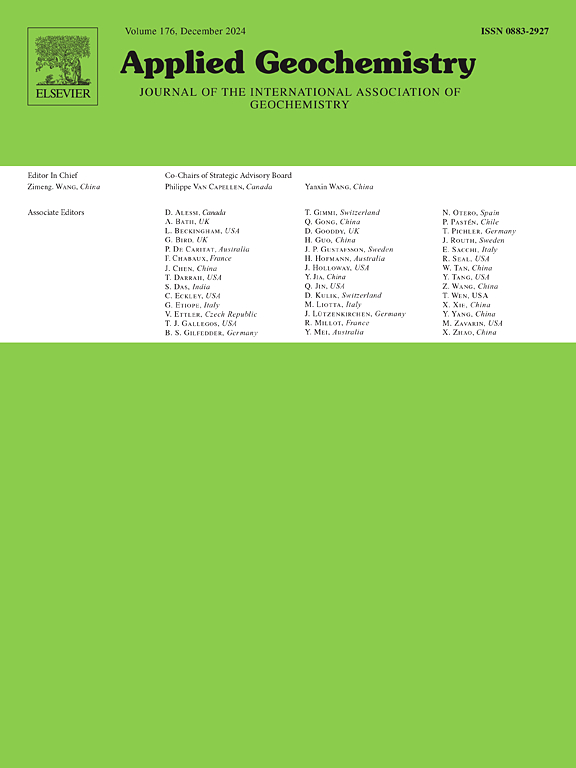基于水化学、稳定同位素和222Rn的中国复盖岩溶盆地多岩溶系统地下水流动模式分异
IF 3.4
3区 地球科学
Q1 GEOCHEMISTRY & GEOPHYSICS
引用次数: 0
摘要
覆盖型岩溶盆地地下水资源丰富,但由于土壤覆盖较厚,地表岩溶特征不明显,使得对地下水流的认识复杂化。综合物理化学参数、稳定氢、氧同位素和氡同位素(222Rn),研究了中国南方覆盖盆地局部、中间和区域岩溶水系的地下水流动特征。目的是区分这些系统之间的差异,检查其出口的氡浓度变化,并评估222Rn在确定地下水流动特征方面的潜力。区域岩溶系统中的地下水具有水岩相互作用最广泛、流道和停留时间最长、人为影响最小、流道后期以裂缝为主的缓慢流动的特点。相比之下,局部和中间岩溶系统对外部变化的响应更大,快速管道流动主要发生在其末端段。由于氡的停留时间和流动路径较短,氡被迅速输送到排放点,导致局部岩溶系统地下水中的氡浓度高于中间系统和区域系统,而中间系统和区域系统的停留时间较长。与水化学和同位素趋势类似,氡在局部和中间系统中的浓度波动比在区域系统中的波动更大,这表明在两者的末端段都有快速流动。氡活度可以定性地识别岩溶含水层的流动特征。水文地球化学、稳定同位素和222Rn数据的整合提供了与含水层结构相关的流动模式的全面理解,并深入了解喀斯特水系统中的氡行为。本文章由计算机程序翻译,如有差异,请以英文原文为准。
Differentiation of groundwater flow patterns in multiple karst systems in a covered karst basin in China through hydrochemistry, stable isotopes, and 222Rn
Groundwater in covered karst basins is abundant, but the thick soil cover and the lack of distinct surface karst features complicate the understanding of subsurface flow. This study integrates physicochemical parameters, stable hydrogen and oxygen isotopes, and the radon isotope (222Rn) to characterize groundwater flow within local, intermediate, and regional karst water systems in a covered basin in South China. The aims are to distinguish differences among these systems, examine radon concentration variations at their outlets, and assess the potential of 222Rn in identifying groundwater flow characteristics. Groundwater in the regional karst system is characterized by the most extensive water-rock interaction, extended flow paths and residence time, minimal anthropogenic influence, and slow, fracture-dominated flow in the final stages of flow paths. In contrast, local and intermediate karst systems are more responsive to external changes, with rapid conduit flow primarily occurring in their terminal sections. Owing to the short residence time and flow paths, radon is rapidly transported to the discharge points, resulting in higher concentrations in groundwater from local karst systems compared to intermediate and regional systems, which have longer residence time. Similar to hydrochemical and isotopic trends, radon concentrations in local and intermediate systems fluctuate more than in regional systems, suggesting rapid flow in the terminal sections of both. Radon activity can qualitatively identify flow characteristics in karst aquifers. The integration of hydrogeochemical, stable isotopes, and 222Rn data provides a comprehensive understanding of flow patterns linked to aquifer structures and insights into radon behavior in karst water systems.
求助全文
通过发布文献求助,成功后即可免费获取论文全文。
去求助
来源期刊

Applied Geochemistry
地学-地球化学与地球物理
CiteScore
6.10
自引率
8.80%
发文量
272
审稿时长
65 days
期刊介绍:
Applied Geochemistry is an international journal devoted to publication of original research papers, rapid research communications and selected review papers in geochemistry and urban geochemistry which have some practical application to an aspect of human endeavour, such as the preservation of the environment, health, waste disposal and the search for resources. Papers on applications of inorganic, organic and isotope geochemistry and geochemical processes are therefore welcome provided they meet the main criterion. Spatial and temporal monitoring case studies are only of interest to our international readership if they present new ideas of broad application.
Topics covered include: (1) Environmental geochemistry (including natural and anthropogenic aspects, and protection and remediation strategies); (2) Hydrogeochemistry (surface and groundwater); (3) Medical (urban) geochemistry; (4) The search for energy resources (in particular unconventional oil and gas or emerging metal resources); (5) Energy exploitation (in particular geothermal energy and CCS); (6) Upgrading of energy and mineral resources where there is a direct geochemical application; and (7) Waste disposal, including nuclear waste disposal.
 求助内容:
求助内容: 应助结果提醒方式:
应助结果提醒方式:


